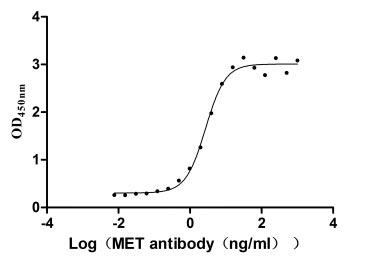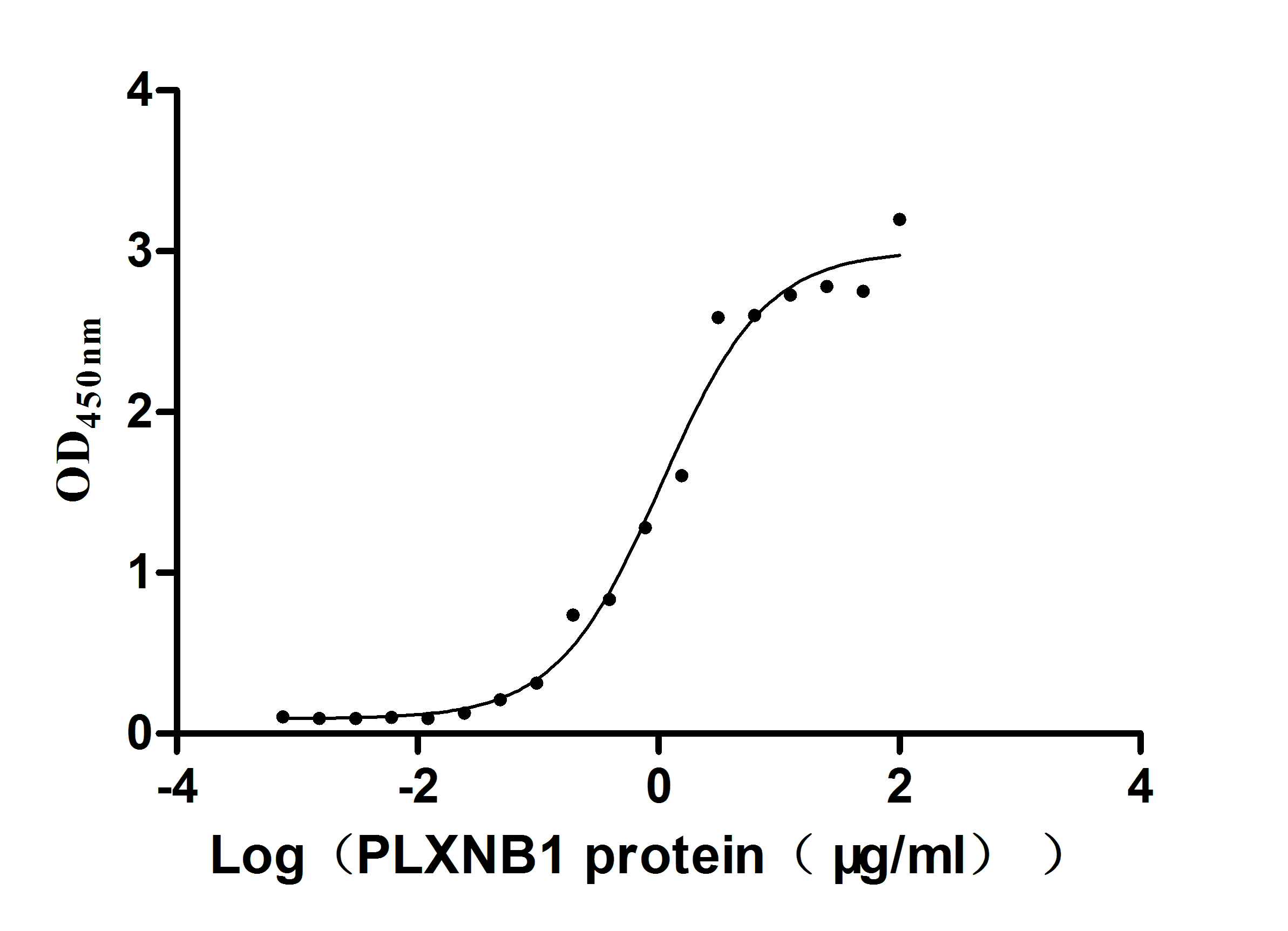Recombinant Mouse Beta-1,3-N-acetylglucosaminyltransferase lunatic fringe (Lfng), partial
-
货号:CSB-YP012881MO1
-
规格:
-
来源:Yeast
-
其他:
-
货号:CSB-EP012881MO1
-
规格:
-
来源:E.coli
-
其他:
-
货号:CSB-EP012881MO1-B
-
规格:
-
来源:E.coli
-
共轭:Avi-tag Biotinylated
E. coli biotin ligase (BirA) is highly specific in covalently attaching biotin to the 15 amino acid AviTag peptide. This recombinant protein was biotinylated in vivo by AviTag-BirA technology, which method is BriA catalyzes amide linkage between the biotin and the specific lysine of the AviTag.
-
其他:
-
货号:CSB-BP012881MO1
-
规格:
-
来源:Baculovirus
-
其他:
-
货号:CSB-MP012881MO1
-
规格:
-
来源:Mammalian cell
-
其他:
产品详情
-
纯度:>85% (SDS-PAGE)
-
基因名:
-
Uniprot No.:
-
别名:Lfng; Beta-1,3-N-acetylglucosaminyltransferase lunatic fringe; O-fucosylpeptide 3-beta-N-acetylglucosaminyltransferase
-
种属:Mus musculus (Mouse)
-
蛋白长度:Partial
-
蛋白标签:Tag type will be determined during the manufacturing process.
The tag type will be determined during production process. If you have specified tag type, please tell us and we will develop the specified tag preferentially. -
产品提供形式:Lyophilized powder
Note: We will preferentially ship the format that we have in stock, however, if you have any special requirement for the format, please remark your requirement when placing the order, we will prepare according to your demand. -
复溶:We recommend that this vial be briefly centrifuged prior to opening to bring the contents to the bottom. Please reconstitute protein in deionized sterile water to a concentration of 0.1-1.0 mg/mL.We recommend to add 5-50% of glycerol (final concentration) and aliquot for long-term storage at -20℃/-80℃. Our default final concentration of glycerol is 50%. Customers could use it as reference.
-
储存条件:Store at -20°C/-80°C upon receipt, aliquoting is necessary for mutiple use. Avoid repeated freeze-thaw cycles.
-
保质期:The shelf life is related to many factors, storage state, buffer ingredients, storage temperature and the stability of the protein itself.
Generally, the shelf life of liquid form is 6 months at -20°C/-80°C. The shelf life of lyophilized form is 12 months at -20°C/-80°C. -
货期:Delivery time may differ from different purchasing way or location, please kindly consult your local distributors for specific delivery time.Note: All of our proteins are default shipped with normal blue ice packs, if you request to ship with dry ice, please communicate with us in advance and extra fees will be charged.
-
注意事项:Repeated freezing and thawing is not recommended. Store working aliquots at 4°C for up to one week.
-
Datasheet :Please contact us to get it.
相关产品
靶点详情
-
功能:Glycosyltransferase that initiates the elongation of O-linked fucose residues attached to EGF-like repeats in the extracellular domain of Notch molecules. Modulates NOTCH1 activity by modifying O-fucose residues at specific EGF-like domains resulting in inhibition of NOTCH1 activation by JAG1 and enhancement of NOTCH1 activation by DLL1 via an increase in its binding to DLL1. Decreases the binding of JAG1 to NOTCH2 but not that of DLL1. Essential mediator of somite segmentation and patterning. During somite boundary formation, it restricts Notch activity in the presomitic mesoderm to a boundary-forming territory in the posterior half of the prospective somite. In this region, Notch function activates a set of genes that are involved in boundary formation and in anterior-posterior somite identity. Ectopically expressed in the thymus, Lfgn inhibits Notch signaling which results in inhibition of T-cell commitment and promotes B-cell development in lymphoid progenitors. May play a role in boundary formation of the enamel knot.
-
基因功能参考文献:
- results suggest that mir-125a sites in the Lfng 3' untranslated region influence transcript turnover in both mouse and chicken embryos, and support the existence of position-dependent regulatory mechanisms in the presomitic mesoderm. PMID: 28710810
- Lfng-mediated Notch signaling appears to be a key factor governing NSC quiescence, division, and fate. PMID: 28699891
- These results show that Notch signaling is finely calibrated in the cochlea via Lfng and Mfng to produce precisely tuned levels of signaling that first set the boundary of the organ of Corti and later regulate hair cell development. PMID: 27966429
- LFNG protein may have context-dependent effects on Notch activity; somitogenesis is disrupted by a novel dominant allele of Lfng PMID: 26811377
- each Fringe contributes to T and B cell development, and Fringe is required for optimal in vitro stimulation of T and B cells. PMID: 26608918
- Lfng expression and activity is normal in mice whose Lfng is lengthened by 10 kb, and no effects on segmentation are evident. PMID: 22326607
- suggest that modulation of the Notch signaling by Lfng affects the clock period during development PMID: 24560643
- STAT5-dependent amplification of Notch-modifying Lfng augments Th2 response via Dll4 and is critical for amplifying viral exacerbation during allergic airway disease. PMID: 24367028
- The repressive effect of Lfng against Notch activities in neighbouring cells can sufficiently explain the synchronization in vivo. PMID: 23072809
- Intriguing changes are observed in the cranio-caudal borders of multifidus muscle in mutant Dll3 and Lfng models of idiopathic scoliosis. PMID: 22095884
- Reduced LFNG expression facilitates JAG/NOTCH luminal progenitor signaling and cooperates with MET/CAVEOLIN basal-type signaling to promote basal-like breast cancer. PMID: 22624713
- the presence of Gal on O-fucose glycans differentially affects DLL1-induced NOTCH signaling modulated by LFNG versus MFNG PMID: 22081605
- Decreasing Lfng expression during the (TCR-CD4/CD8 double negative 3) DN3-DP (CD4/CD8 double positive) transition minimizes the potent leukemogenic potential of Notch1 signaling. PMID: 21097675
- data reveal that Lfng enhances CD4/CD8 double-negative 3b precursor competition for intrathymic Delta-like Notch ligands to maximize Notch-induced clonal expansion during the earliest stage of beta-selection. PMID: 20844195
- Data suggest that lunatic fringe strongly augments Notch signaling mediated by Delta-like 1 but not Jagged 1. PMID: 20510365
- there are differential axial requirements for lunatic fringe and Hes7 transcription during mouse somitogenesis PMID: 19956724
- An evolutionarily conserved region in murine Lunatic fringe (Lfng) promoter drives periodic somite expression. Oscillatory Notch signaling underlies the segmentation clock and directly activates and indirectly represses Lfng expression. PMID: 12110168
- Lunatic fringe (Lfng) expression in the presomitic mesoderm is required for somite segmentation. Independent Lfng regulatory cassettes advance a molecular framework for deciphering this segmentation. PMID: 12110169
- Lunatic fringe, FGF, and BMP regulate the Notch pathway during epithelial morphogenesis of teeth. PMID: 12167404
- Transcriptional oscillation of this protein is essential for somitogenesis. PMID: 12670869
- periodic repression by Hes7 protein is critical for the cyclic transcription of Hes7 and Lfng, and this negative feedback represents a molecular basis for the segmentation clock PMID: 12783854
- Lunatic fringe null female mice were found to be infertile. PMID: 15659488
- The Jsr mutation disrupts the A-P polarity of somites during the somitogenesis without altering Lfng expression pattern in the presomitic mesoderm. PMID: 15822856
- Lunatic fringe and Hes7 controls their oscillatory expression during somitogenesis by forming negative feedback loop PMID: 16342160
- The ability of Lfng and Notch1 to control progenitor competition for limiting cortical niches is an important mechanism for the homeostatic regulation of thymus size. PMID: 16699526
- Shutting down the expression of Lfng in CD4+CD8+DP cells may have a physiological role in promoting DP cells differentiation toward mature CD8+SP cells. PMID: 17142733
- spondylocostal dysostosis (SCD) is caused by mutation in Delta-like 3 (DLL3), Mesoderm posterior 2 (MESP2), and Lunatic fringe (LFNG); three genes that are components of the Notch signaling pathway. PMID: 17600782
- In the absence of oscillatory Lfng expression, mice exhibit severe segmentation phenotypes in the thoracic and lumbar skeleton PMID: 18234727
- Lunatic Fringe (Lfng) and Manic Fringe (Mfng) cooperatively enhanced the DL1-Notch2 interaction to promote marginal zone B cell development PMID: 19217325
- The expression of lunatic fringe oscillates in 2-h cycles in the mouse presomitic mesoder. PMID: 19440349
- No obvious synergistic defects in mice in the absence of two, or all three, fringe genes during development of the axial skeleton, limbs, hindbrain, and cranial nerves. PMID: 19479951
- Lfng functions to enhance Notch signaling in myofibroblast precursor cells and thereby to coordinate differentiation and mobilization of myofibroblasts required for alveolar septation. PMID: 19897741
显示更多
收起更多
-
亚细胞定位:Golgi apparatus membrane; Single-pass type II membrane protein.
-
蛋白家族:Glycosyltransferase 31 family
-
组织特异性:Detected at 12.5 dpc in all tissues examined with the highest level observed in adult brain and spleen. Detected in the dental epithelium.
-
数据库链接:
KEGG: mmu:16848
STRING: 10090.ENSMUSP00000031555
UniGene: Mm.12834
Most popular with customers
-
Recombinant Human Hepatocyte growth factor receptor (MET), partial (Active)
Express system: Mammalian cell
Species: Homo sapiens (Human)
-
Recombinant Human Plexin-B1 (PLXNB1), partial (Active)
Express system: Mammalian cell
Species: Homo sapiens (Human)
-
Recombinant Rabbit Tissue factor pathway inhibitor (TFPI) (Active)
Express system: Mammalian cell
Species: Oryctolagus cuniculus (Rabbit)
-
Recombinant Macaca mulatta Semaphorin-4D isoform 1 (SEMA4D), partial (Active)
Express system: Mammalian cell
Species: Macaca mulatta (Rhesus macaque)
-
Recombinant Human V-set and immunoglobulin domain-containing protein 4 (VSIG4), partial (Active)
Express system: Mammalian cell
Species: Homo sapiens (Human)
-
Recombinant Mouse Cell adhesion molecule 1 (Cadm1), partial (Active)
Express system: Mammalian cell
Species: Mus musculus (Mouse)
-
Recombinant Human Cadherin-17 (CDH17), partial (Active)
Express system: Mammalian cell
Species: Homo sapiens (Human)
-
Express system: Mammalian cell
Species: Homo sapiens (Human)




















